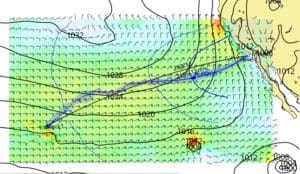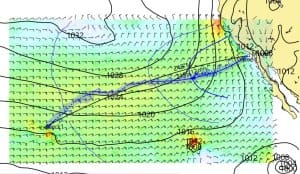BY PETER ISLER

Weather models and their digitized end product, the GRIB file, are key facets of weather forecasting. An understanding of these elements will help any voyaging sailor to better decipher the weather.
When I was in college, I was primarily a dinghy sailor and was just getting started in offshore navigation and race tactics. I knew how to read a weather map and listen to the marine forecast on the VHF radio, but beyond that I just took what Mother Nature gave me. In college, I majored in meteorology since it was the closest subject I could find to my favorite sport. I was schooled in the science (and math) of fluid dynamics — the equations that explained the motion and energy in the atmosphere. Little did I know that these head-breaking formulas would be the building blocks of tools that I would use many years later in my career as a professional sailor. My senior thesis was, I realize now, a simplistic weather model. I built a program that predicted if a sea breeze would form on eastern Long Island Sound based on a simple set of initial observed conditions.
As I learned in college, the atmosphere is a fluid, and its motions are driven by basic forces that were fairly well understood and quantified by the likes of Newton, Pascal and Bernoulli. But it wasn’t until the tools and the resources to measure the state of the atmosphere (pressure, humidity, temperature, wind, etc.) expanded and became refined that these equations had something to sink their teeth into in a practical sense. In his best-selling book The Weather Machine – A Journey inside the Forecast, author Andrew Blum describes the fascinating history of weather measurements and observations. These are the raw data that provide the all-important “initial conditions” that every weather model requires in order to strut its stuff and calculate prognostications of how that “starting point” will evolve in the future.
Worldwide data collection
The worldwide network that shares the raw data used in weather models is a rare example of truly global cooperation. Interestingly, Covid-19 affected this network. Thousands of commercial airliners have sensor packages on board that provide data to the global network about the vertical structure of the atmosphere. The sudden drop in air travel, however, meant fewer planes in the air and thus much less valuable data to feed the weather machine.
Even with all the ways of collecting data — airplanes, satellites, etc. — and all sorts of fast sharing of weather data, the task of nailing down the initial conditions remains one of the biggest challenges to weather model “accuracy.” After all, garbage in = garbage out, and as you can imagine there are still lots of places on the planet where reliable atmospheric data is still very limited.
A weather model takes that set of initial conditions and then applies those good old fluid dynamics and thermal dynamics formulas to come up with its forecast of the future. But the globe is a big place, the atmosphere is three-dimensional, and even today’s fastest computers can only work so fast. The first weather models applied their calculations to theoretical boxes, also known as “grids,” that were huge –– on the order of hundreds of miles on a side. The first models took so long to complete their calculations that their forecasts were “old news” by the time they were produced. But you have to drift before you foil, and the scientists stayed on track as computer power improved until the point when a result/forecast became usable as forecast and not as “hindcast.”
Global models slowly became practical, delivering their results in a timelier fashion. The Global Spectral Model entered service in 1982. That model had a horizontal resolution roughly 2.5 degrees (150 nautical miles) and just 12 vertical layers, with both the horizontal and vertical resolution decreasing at longer forecast steps. For regional forecasts, the Limited Fine Mesh model was available over North America at a resolution of around 125 km — so coarse it didn’t even resolve the Great Lakes!
A dozen good global models
With steady improvement in computer and communication speeds over the years, model resolution, performance, and availability have improved steadily and dramatically. Today there are at least 12 reasonably good global models running in operational mode — some with less than 10 km horizontal resolution and often more than 100 vertical layers. While resolution and run frequency vary among the models, they all bring something to the table when it comes to forecast guidance – especially over open ocean. In addition, multiple global models are run in an ensemble manner, providing hundreds of additional global model runs per day!
At the continental, regional, and local scales, the number of available models is even more staggering. Various national meteorological agencies, universities, and private entities run a countless number of models for specific areas. These higher resolution models are extremely useful for boaters by providing guidance in forecasting near-coastal winds.
But which weather model is best? That question is a bit like asking a builder which tool is best to construct a house. The answer is “it depends.” The more you know about the capabilities and limitations of these digital forecast tools — and the better you can understand and define the problem you want to solve — the better off you will be when selecting your tool(s). And like an experienced house builder, a meteorologist looks at the models as tools, as guidance that will help them come up with a forecast. They don’t view models as some magical version of Alexa that will answer all your weather questions with a simple query. (Does that sound like you and your favorite weather app?)
If you want to go beyond the “Alexa” style use of weather models, the first step is in understanding how a weather model works — including important features like coverage, domain, resolution, and update frequency. This knowledge opens the door to comprehending the common limitations of weather models and how to determine which models might be better in specific applications. With so many models available that are updating so frequently, it’s easy to get overwhelmed. There’s a point of diminishing returns when it comes to the breadth of weather model information. Meteorologists have come up with some clever ways to deal with the amount of model data. One thing that is important is to understand and appreciate the fact that they aren’t an answer, but a guide. Ultimately the best predictions must be consistent with an understanding of the weather and the underlying science. An interesting approach is to realize that even “bad” models can contain useful information, but you often don’t know that a model is “bad” until after the weather has occurred.
If you want to learn more about weather models and marine weather, check out Marine Weather University (marineweatheru.com) – an online school that I created during the Covid lockdown with my weather guru, veteran meteorologist Chris Bedford (America’s Cups, Olympics, Around the World Races). There are dozens of individual classes and two full-length courses that provide a college-level education in marine weather. In MWU’s advanced class, Weather Models 201, we take a deep dive into these ubiquitous and powerful tools so that our students can be like craftsmen with toolboxes full of the best tools. If you are interested, please have a look around our campus and our curriculum.
Peter Isler is an America’s Cup winner, a motivational speaker and author. He is co-founder of the American Sailing Association and Marine Weather University.

